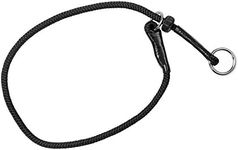Buying Guide for the Best Dog Training Collar
Choosing the right dog training collar can make a significant difference in effectively training your dog while ensuring their comfort and safety. It's important to consider your dog's size, temperament, and the specific training goals you have in mind. A good training collar should be a tool that helps reinforce positive behavior without causing harm or distress to your pet. Understanding the key specifications of dog training collars will help you make an informed decision that aligns with your training needs and your dog's well-being.Type of CollarDog training collars come in various types, including static (shock), vibration, ultrasonic, and spray collars. The type of collar is important because it determines how the collar communicates with your dog. Static collars deliver a mild electric pulse, vibration collars use a buzzing sensation, ultrasonic collars emit a high-pitched sound, and spray collars release a burst of citronella or air. When choosing a type, consider your dog's sensitivity and the training issues you are addressing. For instance, a vibration collar might be suitable for a sensitive dog, while a static collar might be more effective for a stubborn dog.
RangeThe range of a dog training collar refers to the maximum distance over which the remote can communicate with the collar. This is important for training in different environments, especially if you plan to train your dog outdoors or in large areas. Ranges can vary from a few hundred feet to several miles. If you primarily train in a backyard, a shorter range may suffice. However, for field training or off-leash activities, a longer range is beneficial to maintain control over your dog.
AdjustabilityAdjustability refers to the ability to change the intensity of the correction or stimulation delivered by the collar. This is crucial for tailoring the training experience to your dog's size, temperament, and response to the collar. Most collars offer multiple levels of intensity, allowing you to start with the lowest setting and gradually increase if necessary. Choose a collar with a wide range of adjustability to ensure it can be customized to your dog's needs and to avoid overstimulation.
Size and FitThe size and fit of the collar are essential for your dog's comfort and the effectiveness of the training. A collar that is too tight can cause discomfort or injury, while one that is too loose may not function properly. Collars are usually adjustable, but it's important to measure your dog's neck and choose a collar that fits well within the adjustable range. Ensure the collar is snug but not too tight, allowing you to fit two fingers between the collar and your dog's neck.
Battery LifeBattery life is an important consideration, especially if you plan to use the collar frequently or for extended periods. A collar with a long battery life reduces the need for frequent recharging and ensures the collar is ready when you need it. Some collars use rechargeable batteries, while others use replaceable ones. Consider your convenience and the collar's usage pattern when choosing between these options. A longer battery life is generally more convenient for active training sessions.
Water ResistanceWater resistance is a key feature if your dog is likely to encounter wet conditions, such as rain, puddles, or swimming. A water-resistant or waterproof collar ensures that the device continues to function properly in these situations. If your training involves outdoor activities or if your dog enjoys water play, opt for a collar with a high level of water resistance to prevent damage and ensure reliability.








